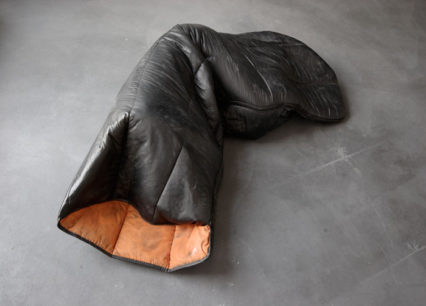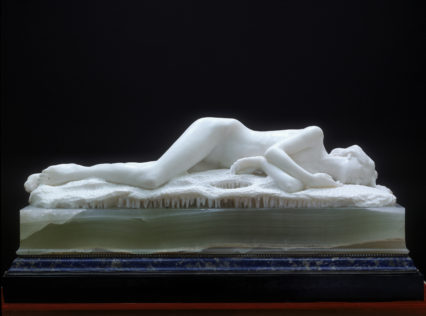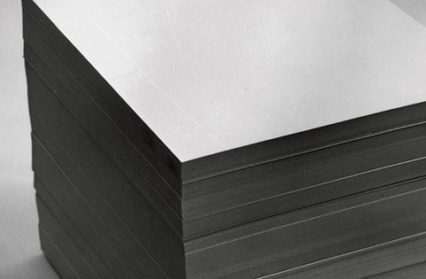Although Elizabeth Price is regarded as a “video artist” (she did win the Turner Prize as one in 2012, after all), her work often tends to capture and utilise the power of many mediums. She manipulates with film, she delivers with film, but her material is the history of the image. And so it is no great leap that Price also takes easily to curatorship, bringing together a wide array of mediums to explore and tie together the themes of this Hayward Touring Exhibition that has landed at Swansea’s Glynn Vivian.
In A Dream You Saw A Way To Survive And You Were Full Of Joy (the title itself a homage to Jenny Holzer’s 1997 “Bench”, from her Survival Series), is a journey through a predominantly monochrome space where dream and death and elation are all fluidly, claustrophobically interlinked. This is an intense experience, the space pulling the viewer through closely arranged exhibits of movie excerpts, photographs, sketches, paintings, sculptures, archival and installation pieces, and more. It starts slow, contemplative, surrounded by sleepers sleeping, and builds to the rough and ready bounding of dance. On the way we pass through the realms of “Working” and “Mourning”, and perhaps (along with “Sleeping” and “Dancing”) the themed rooms do no quite need so much framing – there is the suggestion here of a need for flow, and the sub-headings jolt a little.

But Price shows herself a more than capable curator, with a breadth of knowledge and vision that almost threatens to spill over and drown any attempts at subtlety. But the overriding feeling is that when it comes to the show’s deficiencies, it is the space that lets her down. For so many ideas to be arranged in such close proximity is accumulatively suffocating, and, sadly, by the climax fatigue sets in.
But for the main, we can revel in Price’s eclectic vision. Immediately we can see she is talking in parallels, drawing our eyes from one idea to the next with an obsessive – and far from subtle – control. An excerpt from Charles Laughton’s only film as director, the terrifying cult classic The Night of the Hunter (1955) is just a few feet away from a Brian Altero photograph of two figures on opposite riverbanks, seemingly ignorant of one another. The moods are the same – Laughton shot with a dreamlike black and white, all inky shadows and shimmering moonlight, and Altero is in the same realm. And so are we – just a few steps and we are in that space between reality and dream. Henry Moore’s “Fitful Sleepers” (1941) makes grassy mounds out of reclining figures in that portentous, primeval way of his. The figures writhe; this is dangerous, birth of the universe stuff, and Moore’s modest sketch is without doubt the boldest way to open. It is opposite The Night of the Hunter which hangs on a screen like a beaten carpet in the middle of the room, Moore’s pit of men its audience. Moore requires what John Berger termed a “pliable imagination” to really appreciate his mastery, and in this few square inches you can see both the beginning and the end of our species, and they are seconds apart.

Price plays this trick throughout, and it never quite stops being effective. Three works face each other and spit out parallels in the next space. Gialio Paolini’s “Necessaire” (1968) is, conceptually, Price’s starting point for the whole exhibition. It sticks out here like a sore thumb. A stack of blank paper, it is as pointless or as profound as you wish it to be. Paolini is an artist who suffers fools quite gladly. But here it is opposite a series of arctic diagrams and cartographic sketches of icebergs and subtropical coastlines from the golden age of exploration. Next in this triptych is Edward Onslow Ford’s “Snowdrift” (1901), a haunting funereal relief of dripping marble, the figure (the personification of winter) atop it leading us from sleep to death. The melting of form is a sad sight, and Paolini’s work stands impervious to it. It is not an endearing victory.
In a Dream… is eager to impress, eager to pull you around its five spaces and throw cross-reference after cross reference at you. It’s impossible to tell if such grave enthusiasm works, as most things are cramped together – one could almost trip over Gavin Turk’s “Nomad” (2001), a painted bronze of curving sleeping bag that will inspire dread in anyone familiar with Takeshi Miike’s Audition (1999). But perhaps all the space a visitor needs is in the endless silence of the stills (the intrusive soundtracks of the video installations are less alluring). In “Working” we are introduced to basic modernist images, the stuff of human nonchalance and boredom, factory work and agricultural toil, the marvellous brutal symmetry of Gustav Metzer’s photographs of looms and bottles and cogs and pistons.
In “Mourning” we are forced to rethink the photographs of sleepers we have seen earlier. Can we now think of David Goldblatt’s photograph of a black man asleep in a park in Johannesburg without thinking of Apartheid? Marketa Luskacova’s “Pilgrims” (1971) now begins to cast spells of nightmares of fields of scattered bodies. Goldblatt’s beautiful “A Widow in her House” is one of the most moving pieces on show. Evan Walter’s “Deathmask of the Artist” is there to remind us of the immortality of the image over the pathetic impermanence of the image creator. But here it is also important to remember that an artist’s deathmask is the most profound of statements, a solid three dimensional attempt of the artist, in death, to control the image, rather than hand control of the image over to another. It is about reaching into death as well as reaching out of it. What is it Price wants us to draw from this inclusion? There is a suspicion here that by including so much, by casting so broadly, Price’s own vision has become blurred. Artefacts such as the Walters’ piece – exhibits that jut out into your intellectual line of vision and stay there – appear in every room. There is a danger all this amounts to an intangible cohesion.
In a Dream…, to put it simply, is too busy. But that is not to say Price is not a curator with an admirable knowledge-base and an energetic eye for pulling together thematic ideas. What this show needed was a tad more focus and a lot more room.
In a Dream You Saw a Way to Survive and You Were Full of Joy is at the Glynn Vivian Gallery in Swansea until August 28th.
Images used with kind permission.



 Enjoyed this article? Support our writers directly by buying them a coffee and clicking this link.
Enjoyed this article? Support our writers directly by buying them a coffee and clicking this link.








